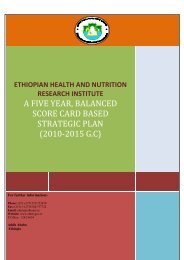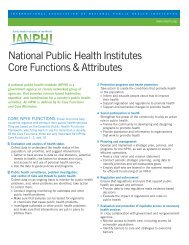Afghanistan Afghan Public Health Institute Strategic Plan - ianphi
Afghanistan Afghan Public Health Institute Strategic Plan - ianphi
Afghanistan Afghan Public Health Institute Strategic Plan - ianphi
Create successful ePaper yourself
Turn your PDF publications into a flip-book with our unique Google optimized e-Paper software.
Personal <strong>Health</strong> Practices and Coping Skills – People’s knowledge and understanding of healthpromoting actions and positive coping skills, and environments that support and enable healthychoices, strongly influence health. These are areas that require much attention in <strong><strong>Afghan</strong>istan</strong>.<strong>Health</strong>y Child Development – Providing young children with stimulating, safe and nurturingenvironments, as well as nutritious food and exercise, lay the foundations for healthy adulthood.What a woman eats during pregnancy influences the neurological, as well as the physiologicaldevelopment of her baby. The importance of good nutrition for mothers during and after pregnancy,as well as their children, has a strong impact on society’s health. This is a critical area of focus for<strong><strong>Afghan</strong>istan</strong>.<strong>Health</strong> Services ‐ Access to quality health services, particularly those that assist in preventing illnessand promoting health, contribute to population health.In addition to depicting eleven determinants of health or WHAT to take action on, the Population<strong>Health</strong> Promotion Model in Figure 1 identifies WHO may take action to promote health, HOW actioncan be taken, and WHY it is important to take action to improve health. For more indepthinformation please refer to A Population <strong>Health</strong> Promotion Framework for Saskatchewan Regional<strong>Health</strong> Authorities, Towards a Population <strong>Health</strong> Promotion Approach, February, 2006 and a numberof WHO documents accessible at http://www.int/social_determinants/en .BACKGROUND AND CONTEXTBefore the departure of the Taliban in late 2001, Nongovernmental Organizations (NGOs) played astrong role in providing health services, with little or no influence or coordination from the MoPH.<strong>Health</strong> services were fragmented and focused in urban areas; leaving many rural areas and insecureareas unserved or underserved.In 2003, the MoPH made the decision, with the support of donors, to change its role to astewardship role. That decision, resulted in the development of and contracting out through NGOs,of a Basic Package of <strong>Health</strong> Services (BPHS). “The goal in developing the BPHS was to provide astandardized package of basic services that would form the core of service delivery in all health care facilities”(A Basic Package of <strong>Health</strong> Services for <strong><strong>Afghan</strong>istan</strong>, 2005). In 2005, the BPHS was revised based onpositive impacts on a number of health indicators (including maternal mortality, infant and under 5mortality, increased access to services and increased immunization coverage). The details arepresented in Table 1 in the Desired Results for 2015 section of this document. The BPHS was furtherrevised in 2010.An Essential Package of Hospital Services (EPHS) was later added, focusing on hospitals, improvingtheir facilities and equipment, staff training and development and enhancing the referrals betweendifferent levels of the health system. Currently, contracting out by NGOs to deliver health serviceshas been implemented in 31 provinces, with the support of the EU, USAID and World Bank. Threeprovinces are “contracting in”; where MoPH staff are contracted, similar to NGOs, to deliver theservices.Ministry of <strong>Public</strong> <strong>Health</strong> <strong>Strategic</strong> <strong>Plan</strong>, 2011‐201518




